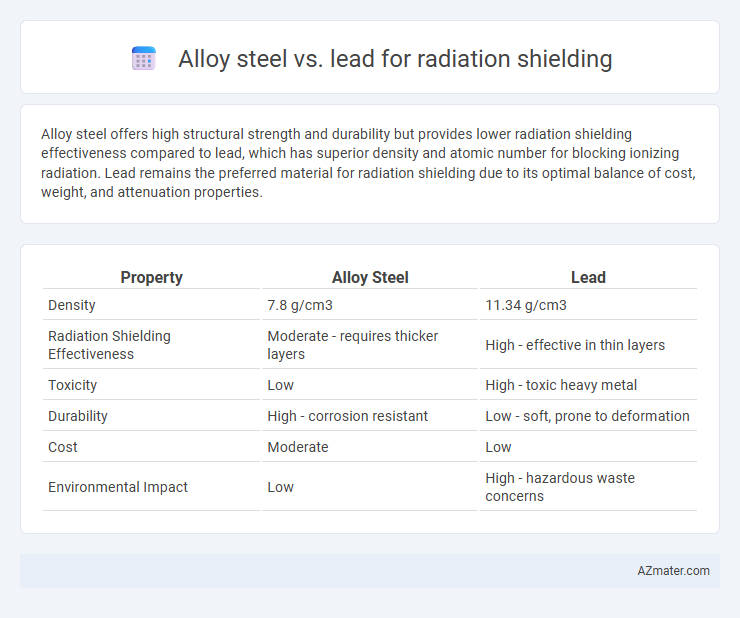Alloy steel offers high structural strength and durability but provides lower radiation shielding effectiveness compared to lead, which has superior density and atomic number for blocking ionizing radiation. Lead remains the preferred material for radiation shielding due to its optimal balance of cost, weight, and attenuation properties.
Table of Comparison
| Property | Alloy Steel | Lead |
|---|---|---|
| Density | 7.8 g/cm3 | 11.34 g/cm3 |
| Radiation Shielding Effectiveness | Moderate - requires thicker layers | High - effective in thin layers |
| Toxicity | Low | High - toxic heavy metal |
| Durability | High - corrosion resistant | Low - soft, prone to deformation |
| Cost | Moderate | Low |
| Environmental Impact | Low | High - hazardous waste concerns |
Introduction to Radiation Shielding Materials
Radiation shielding materials are designed to protect against harmful ionizing radiation by absorbing or attenuating radiation particles and energy. Alloy steel, known for its high density and mechanical strength, provides effective gamma and neutron radiation shielding while maintaining structural integrity in harsh environments. Lead remains a preferred material due to its superior density and ability to absorb gamma rays efficiently but is limited by its toxicity and lower mechanical strength compared to alloy steel.
Overview of Alloy Steel in Radiation Protection
Alloy steel in radiation protection offers enhanced mechanical strength and durability compared to traditional lead shielding, making it suitable for structural applications in nuclear facilities. Its composition, typically including elements like chromium and nickel, provides improved resistance to radiation-induced damage and corrosion. While alloy steel has lower density than lead, its structural advantages and environmental safety make it a valuable alternative in radiation shielding solutions.
Lead: Traditional Shielding Material Explained
Lead remains the traditional shielding material for radiation due to its high density and atomic number, which effectively attenuate gamma rays and X-rays. Its malleability allows easy fabrication into various shapes and thicknesses, making it a versatile choice in medical, industrial, and nuclear applications. Despite environmental and health concerns, lead's superior radiation absorption properties often outweigh alternatives like alloy steel in specific shielding contexts.
Radiation Attenuation Properties: Alloy Steel vs Lead
Alloy steel offers moderate radiation attenuation due to its density and composition, making it effective against gamma rays and X-rays but less efficient than lead. Lead's high atomic number and density grant superior attenuation properties, providing excellent shielding with thinner layers against both gamma rays and X-rays. Despite lead's effectiveness, alloy steel is preferred in applications requiring structural strength combined with radiation protection.
Weight and Density Considerations
Alloy steel offers a higher strength-to-weight ratio compared to lead, making it a lighter option for structural radiation shielding without compromising durability. Lead has a higher density of approximately 11.34 g/cm3, providing superior attenuation of radiation but resulting in significantly heavier shielding solutions. Weight-sensitive applications benefit from alloy steel's lower density, typically around 7.8 g/cm3, balancing effective radiation protection with reduced load-bearing requirements.
Mechanical Strength and Durability
Alloy steel offers superior mechanical strength and durability compared to lead, making it more resistant to deformation and wear in radiation shielding applications. Its high tensile strength and ability to withstand harsh environmental conditions ensure longer service life and reduced maintenance. Lead, while effective at attenuating radiation due to its high density, is softer and prone to damage, limiting its structural reliability in shielding installations.
Corrosion Resistance and Longevity
Alloy steel offers superior corrosion resistance compared to lead, making it more durable in harsh environments where radiation shielding is required. Its high tensile strength and resistance to oxidization ensure a longer lifespan in structural applications exposed to moisture or chemicals. Lead, while effective at radiation attenuation, is prone to corrosion and degradation over time, reducing its longevity and increasing maintenance costs.
Health and Environmental Impacts
Alloy steel offers superior structural strength and corrosion resistance compared to lead, reducing environmental contamination risks during use and disposal. Lead, while highly effective at radiation shielding, poses significant health hazards due to its toxicity and potential for bioaccumulation, leading to neurological and systemic damage upon exposure. Using alloy steel minimizes long-term environmental pollution and health risks, making it a safer alternative for radiation shielding in medical and industrial applications.
Cost and Availability Comparison
Alloy steel offers a cost-effective and widely available alternative to lead for radiation shielding, benefiting from established industrial production and easier sourcing. While lead provides superior radiation attenuation per unit thickness, its higher material cost and environmental disposal concerns make alloy steel preferable in budget-sensitive projects. The broader availability and recyclability of alloy steel contribute to long-term cost savings in radiation shielding applications.
Applications and Recommendations for Use
Alloy steel offers robust mechanical strength and moderate radiation shielding, making it ideal for structural components in nuclear reactors and medical imaging facilities where both durability and protection are necessary. Lead provides superior gamma and X-ray attenuation due to its high density, commonly used in protective barriers, aprons, and containers for radioactive materials. For applications requiring lightweight and structural integrity alongside radiation protection, alloy steel is recommended, while lead is preferred when maximum radiation absorption is critical despite its toxicity and weight concerns.

Infographic: Alloy steel vs Lead for Radiation shielding
 azmater.com
azmater.com